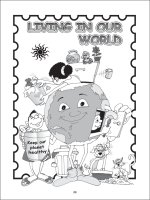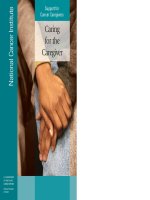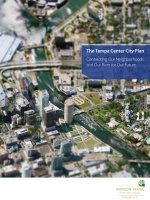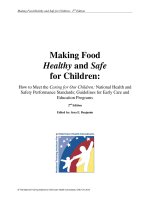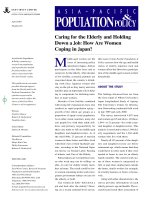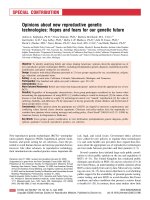caring for our planet
Bạn đang xem bản rút gọn của tài liệu. Xem và tải ngay bản đầy đủ của tài liệu tại đây (29.09 MB, 30 trang )
Caring
for
Our Planet
Joyce
Hannam
Read
and discover all about caring
for our
beautiful
planet
Earth
.
What is
global
warming?
.
How
can
we keep
our
ptanet
ctean?
Read
and discover more
about
the world!
This
series of non-fiction readers
provides
interesting
and educationaI
content,
with
activities and
project
work.
Series
Editor:
HazeI Geatches
Audio
CD Pack avaitable
Word
count
for
thls reader: 3,804
/ih
\t/
6Tl
\i7
/
S
floYo"L,9,,,*,,,,,.
v,
r
t)lror,,(tfA{)h:
Getty lmages
{Satettite
view
of
Planet Iitrllr
\t(', hrr,.l,
Level
3
irii{)
l}r.r.tdwordS
Leve[
4
750 headwords
P
a
@fior
Our
Pl
anet
Joyce
Hannam
Introduction
3
1 Using
Resources Carefu[[y
4
2 Keeping Our
Planet Coo[ 8
3
Making Clean
Electricity t2
4
Reducing Travel
16
5
Keeping Our
Planet Clean
20
5
Protecting
Ptants
24
7 Protecting
Animals
28
8
The Way
Forward 32
Activities
36
Projects
52
Glossary
54
About Read and
Discover 56
OXFORD
UNIVERSITY
PRESS
(
)x F
()t{l)
I Nt\',t RstI\ I'tt ss
(.r(,rl (
I.rR rr(lotl Slrecl,
()\li)r(l
()x:l
6l)r'
(
)\
lr,f(l I
I
ll
ivcf\tl
y
l'R'\s t\ ll
(lrl).t
fl illenl
(
ll
I ll(' I
lniv('rsily
r)l
(
)\lorl
ll llrl ltr.rs t l(. l
lnrvelsily
s ol)i('(1
iv(.
ol
(.x(ellcrr(c
Il r1.\(.il1J].
s(lrr)Llr\l)il).
;ilrd edrk iltio!r l)y
pul)lishing
rvorlrlwjrlt ttt
()\l0r(l
N(wY()rl(
/\il( i(l.ur(l
(ll)("li)wD
l)irres Srham HongKong
Karachi
(
r r.r Lr
I
r
I D)
l)r
r I N4ir(l ri(l lMoll)ourne Mc'xico
City Nairobi
Nr.w
l)( llr Slr.ilrglriri'l:tjl)ci
lbronto
\\'rl lr 0lli(r.s
i tl
Arrgcrrtin.r
Arrstrirr llrazil Chilc CzechRepublic
France
(,r11\(
(;il;rtcrnrh
llul)grly ltrly.lilpan Poland Portugal
\llrlt.rlr)r1
S(trtth
Kr)rcr Swilzcrlnnd'l'hailand Turkey
I
ll(f.Inc
Vt('t
nitll
ox
r
or
rr .rrrrl ox
I'otu) li N(; t.tstt are registered
trade nriuks
oI
(
)\I{,r(l
I
Iniv('rs'ly
I'rcss ir)
thc
IJK
ilr)d in cemnin otl]cr
(
orilrllies
r)
(
)\li )r(l
I
llt
iv('l sil
y
I)rcss 2o I o
I lre rrrrrr':rl
rirllls
ol
ll)c itulhol ltilve l)celt asserted
|)rlirl)irse rirhl
()xli)rd
tJnivcrsity l)f('ss
(nuker)
l;irsl
l)lrl)lish(al
?oIo
l()t.l l(,t:l
?()12 20lt 20lo
|)9U7654:t2
No unauthorized
photocopying
All right s
rcseryed. No
prrt
ol this
publication
may be
rcpr(xln(ed.
storcd in l retrieval system,
ortEnslnitted,
in rny loLm or by aDy mcaDs.
without the
prior pemission
i D wril ing ol Oxford
University Press, or as expressly
Ix,rnritled
by llw, or under temrs agTeed with the appropriate
rcprographics
rights organization. Enquides concening
r('l)ntduction
outside the scope ofthe .rbove should
be sent
lo Ilre lllil Rights DepartneDt,
OxfordUniversityPress, at
thc ad(lress above
You nust Dot circulate
this book in any other binding or
c()vcr rnd
you
must impose this same condition on any
itaquifcr
Ar)y wfl)sitcs ret-eued
to in this
publication
are in the
l)ul)li(
dorurirr rnd their addresses are
provided
by
Oxford
tlrriveNity l\'css for infornation
only.
Oxford
University
I'ress rlisc)aims any responsibility
for the content
I s B N:
97ll
o 19
464559
r
An Au(lio
(il)
I'rck
coutniniDg tltis book and a CD is also
ilvililif bl('. I s B N
978
tt 19
464599
j
'I
I)('(:l) hirs:r
(
hoi(e ol Antcriciln
rnd British English
rf(r)rdir)As
()l
lhc
(1)trrl)icte
lcxt.
n D irc(r)nrl)ilIyiIg Activity
Book is also available,
r\xN,)7ll o t{)
{(),ls(x)
o
l\'it)l(.(l in
(
lhi!):r
'l
his brxrk is
printed
on
plrpt,r
litrnr
ccrtiliecl and
well r)liilrirAc(l s()ufccs.
ll|r\lr,rlr,,r\1,1 l(r,lly hr,rrrrrtly
l)l)
l(' 11.,15;
l)llsillt I'Jvli(/
Ikl lrrr'lllrr\tr,rtr,!r
I'
tt,. /\1,ilt
l{ow(
l).ll():
Mllrk Rulllepp.8.
j
t. ts t,
l
lr,
llr/,li\lr,
r \
xlil1,1 rri\r' irLr lr) liilrl IIf
./illowing Jir
their kin)
lt''1,rir\,r)fr
lr, f.i)rxir/
Itk)l{lqrdlta
dnli
(rlhtt
collyrightmqtffioll
Alamy
Pp.5
(l'icture
CoDtlct),7
(WayDe
Hutchinson),9
(Helga
Lutz/nood). 14
(K-Photos/wiDd
tarn),
l5 (.John
Hensall), 17
Uohnny
Creig Travel Photography). 20
(David
Ball), 22
(Stuart
Kelly), 23
(floralpik/compost
bin). 27
(Edwird
Parker), 28
(Frans
l€mmens), 31
(Mike
Hill), 33
(Photoshot
Holdings Ltd);
Getty Images
pp.4 (Carl
Warner),
10
(Torsten
Blackwood/
AFP), f 3
(Felipe
Rodriguez Fernandez/Photographer's Choice/
solar
power
station), 14
(Robert
FrancisiRobert Harding
world
hnageryisvafisengil, 25
tRob
and Arn SimpsoirlVisuals
Unlimited/periwinkle), 34
(Julian
Sullivan); Robert Gilhooly
p.23 (Kamikatsu
recycliDg);
Oxford University Press
pp.3,
6, 16, 18, 25
(olive
oil), 26, 29, 30, 35; PA Photos
p.19 (AP/
Qiinetiqcom/Press
Association Images); Practical
Action
pp.9
(floating garden),
1 1
(high
house):
Still Pictures
pp.12
(Fred
Dott.Hamburg/Argus-foto), 1 3
(Mark
Edwards/solar cooker),
21
(RLSMI
SENAN-UNtsP),32
(Nigel
DickiDSon).
With thanks
to
Ann |ullick fbr
science chc'ckine
An@ducffi@m
On
our
planet
Earth
there are many beautiful
places.
Sadty,
some of the things that
people
do are
damaging
our
planet.
We
must care for it,
to
keep it
safe and clean
for a[[
the
plants,
animals, and
people
living here.
What beautiful
ptaces
can
you
see betow?
What
beautiful
places
are there
in
your
country?
How
do
peopte
damage
our
planet?
How
can we care for
our
ptanet?
Now read
and discover
more
rt
caring
for
our beautifut
ptanet!
Usflng
lBes@qffi@@s
Cameffiqilry
We
All Need
Water
\7ater is one of the
most important natural
resources
on
Earth.W'e need fresh water to drink, and
we need it
to
grow
and cook
food, and to wash.
Plants, animals,
and
people
all
need water to
live.
About 70% of
Earth is covered with water, but
most
of this water is salt water
in oceans. People
need fresh
water to drink, but only about
3o/o of Earth's water
is fresh water.
In
some countries
there isn't enough water.
Sometimes,
people
have to travel a
long
way
to collect
water, or they
move
to a
new
place
where there
is water.
Our
ptanet gives
us many natural resources
like
air
to breathe and water
to drink.
lt
gives
us
plants
and
animals
to eat, and coa[ and
oil to
make
electricity.
We need
to use a[[ these resources
careful[y.
Renewable
Resources
Some
natural
resources, like
water, sun, wind, soil,
animals, and
plants,
can replace
themselves
naturally.
They are called renewable
resources. They
will not
run out if
we don't use them
too
quickly.
If we use
them carefully,
we will
have
lots of these resources
to
use for a long time.
/1
/
Non-
Renewa ble
Resou rces
Sfe use fossil fuels
like
coal,
gas,
and oil in
power
stations
to make
electricity.\7e
use electricity
to
power
lights. Refrigerators,
televisions,
and
computers
all
neeci
electricity,
too. Many
people
use
electricity
to
cook and
to heat
their homes.
\(/e also use
electricitv
to
power
some
vehicles, and
we use
oil to make
gasoline
to
power
cars
and other vehicles.
The
problem
is that
these fossil fuels
cannot
be
replaced,
so when
we have
used them
all, they will
run
out. They
are
called non-renewable
resources!
and we are
using them
too
quickly.
Pollution
Sometimes we
make our
resources dirty.
This is called
pollution.S(/e pollute
the air when
we use
fossil fuels
to
make energy
like electricity.
\We
pollute
water
when
we
put
waste
into it. People, animals,
and
plants
all
need clean air and
water.
What
Can
We
Do?
There are
lots
of
ways we can
help.'We
must keep
water
clean, and we
must
not waste
it.
Some
charities
are
helping
people
to collect and
store water.
They are
also building
new
dams,
wells,
and
pumps,
so that
people
can
have clean water
nearer their
homes.
We
must
use
non-renewable
resources
carefully,
and we
must
not
waste
them. Scientists
are
mvesugaung ways
to use
renewable
resources,
like
sun,
wind,
and water,
to
make electricity
so that
we don't
need to use so
many fossil
fuels.
\il7e
can
also try
to use
less
electricity.
h
V|AA7, the
four countries
that used
the most
Go to
pages
36-37
for activities.
[fr@@pf,ng
@qm
PilonffiC@@il
Scientists
think
that
Earth's
climate is
changing
and
the
weather
is
getting
more
extreme. They
think
that this is
happening
because
Earth is
getting
warmer.
Why is
this
happening,
and how
can
we keep
our
planet
coot?
The
Greenhouse Effect
llarth
gets
heat
from
the sun.
Some of
the
heat
escapes
into
space,
but some is
trapped
by a
blanket of
gases.
This keeps
Earth
warm
enough for
us
to
live
here,
and it's
called the
greenhouse
effect
because it works
like
a
greenhouse.
\$
GlobalWarming
'When
we
use fossil fuels
we make
a
gas
called
carbon
dioxide.
Scientists
think that
we are
putting
too much
carbon
dioxide into
the air. The
carbon
dioxide
increases
the
greenhouse
effect
and Earth
gets
warmer. This
is
called
global
warming.
Extreme
Weather
Scientists think
that
global
warming
is changing our
climate and
making the weather
more extreme.
This is
a
problem
for
people,
animals, and
plants.
Hurricanes are
getting
more dangerous.
In 2005, a
huge hurricane hit New Orleans
in
the USA.
About
2,000
people
died, and
most of the city was
flooded.
There are
many rivers in Bangladesh.
There are always
floods in the
rainy season, but the
floods are
getting
worse. Every
year,
some
people
die
and thousands of
people
lose their homes.
t\
-
''J
tr4)*
''5(J,
In Bangladesh, some
-peopte
make
fl.oating
gardens.
They
grow
food
on
them, so that they
have
food during the
floods.
lrr thc Sahara Desert in Africa, there
is not
enough
nrirr and the desert
is
getting
bigger.
People have left
tlrcir homes because they can't
grow
food.The
Gobi
l)cscrt in
China and
Mongolia is also
getting
bigger.
I
)cscrt
sand
blows all the way
into cities in North
l(orca and
South
Korea.
Melting lce
l,hrth is
gctting
warmer and the ice is melting at the
North and South Poles. As this
ice
changes to water,
tlrt'
scu lcvcl is
getting
higher.This
is dangerous
for
Iow r'orrntrics
like Bangladesh,
and
for low islands.
'l\rvrrltr
is u country in the Pacific
Ocean
and
it's
made
ul
gnrrrps
ol'islands. Parts of the
capital,
Funafati, are
ttuw
ottly
l0 ccntimeters
above
sea
level. Scientists
tlrtrrk
tltnt
thc
occan
will soon cover the land, and
llte
pcoplc
wlro
livc thcre will have to move to other
ItttUlltt'lcri
likc
Ncw
Tcaland orAustralia.
What Can We
Do?
Scientists
are investigating ways
of
predicting
extreme
weather so that
people
can be
ready for it.
Charities
are working with
people
to build stronger and
higher
homes. They are also
giving people
special
radios
so
that they can
hear
about
extreme weather and
move
to a safer
place.
Our
planet
has natural ways
to reduce carbon dioxide.
Oceans
and
plants
use carbon
dioxide, so we
must
protect
our oceans and
plants.
$(/e
must try to
keep Earth cool by using
fewer fossil
fuels and
producing
less carbon dioxide.
W'e need
electricity, but we
can make it without using
fossil
fuels. Instead, we
can use nuclear energy,
or natural
energy
from the sun, wind, or
water.
)
Go to
pages
38-39
for
activities.
Maffing
CtrXeon
Eil@ffie@
Scientists
are
investigating
ways
of
making
clean
electricity
that
is
not made with
fossil fuels.
This is
important
if we want
to reduce
gtobat
warming
and
pollution.
How is
electricity made
in
your
country?
Nuclear Energy
Nuclear
power
stations
make
electricity
without using
fossil
fuels.
They
don't
put
carbon dioxide into
the
air,
but they
produce
dangerous
radioactive
waste.
This
waste is
put
underground
or
under the
ocean, where
it must
stay for thousands
of
years
before it's
safe.
If there's
an
accident at a nuclear
power
station,
dangerous radioactive
waste can
get
into
the
air
and travel
a
long
way. In 1986
an
accident happened
in
Chernobyl in
Ukraine. People
died
and many more
people
were
sick. About
336,000
people
had
to move
away to new homes.
Scientists
are working hard
to
make nuclear
power
stations
safer.
Solar
Energy
Another
way to
make electricity
is to use the
heat
from the sun. Solar
power
stations only
work well
in
places
where it's very sunny
all
year
long.
In many countries,
people
use solar energy
from
solar
panels
to
heat water in
homes, offices, and
swimming
pools,
and
to
power
watches,
calculators,
and
road signs.
In
sunny
countries,
you
can
cook by using only
heat from the sun. At[
you
need is sunshine
and a
solar
panet!
Wind
Energy
Wind turbines
use the
energy
from
the wind
to
make
electricity.'We
can
build wind
turbines in
isolated
places
and
also
in
the oceans.
They
can
be useful in
colder
countries
where
there is
not
enough
sunshine
to
use solar
energy to make
electricity.
Germany,
for
example,
makes
6o/o of its electricity
in
wind farms.
All
around
the
world there
are more
and more
wind
farms.
Geothermal
Energy
Geothermal
energy
comes from
the heat
that is
trapped
underground.
Hot
water and
steam from
underground
can
be used to heat
buildings,
and to make
electricity.
In Iceland
there is
lots
of hot
water underground.
Geothermal
power
stations
make
about
25o/o
of
Iceland's
electricitv.
Hot water
from
the
Svartsengi
geothermal
power
station
in lcetand
is
used to
ilitffi
fitt an
outdoor
poo[.
lt's
enough
for
swimming.
Energy
trom
Water
\il7e
can
make electricity by using energy
from
moving water
in rivers, lakes, or oceans. This
is
called hydroelectricity.
The first hydroelectric
power
station was built
in 1882. It was a simple water
wheel.
It made
enough
electricity
for 250 light
bulbs.
The
biggest
hydroelectric
power
station
in
the world
today is the
Three
Gorges
Dam in China.
It
can
make
enough electricity
for whole cities!
lP!r.
l:>t
In
1966,
scientists
in France started to
make
electricity using
energy
from
ocean
tides. Then other
scientists used energy
from waves. Scientists
are now
investigating better ways
of using energy
from tides
and waves to
make cheap and clean electricity.
I
Go to
pages
40-4t for activities.
Most
of us travel
to school or to work
every day. Maybe
we
travel
by
car
to
go
shopping or to
visit
friends, or
by
ptane
to
go
on
vacation.
Why should we
trave[ less?
The
Problem
with Travel
Cars,
planes,
buses,
and ships all
put
carbon dioxide
into the
air.
This
increases
the
greenhouse
effect and
makes
our
planet
warmer.
Vehicles also
pollute
the air
with other
gases.
This
makes
our cities
dirty.
Airports
are
getting
very very
busy. About
59,000 internationaI
passengers
travel through
the main
airport in New
York
every day.
What
Can
We
Do?
It's very
difficult to stop traveling,
but we can think
carefully about the
way we travel. For short
journeys,
we can walk
or cycle.
This is
also better than
sitting
in
a car because
exercise
is
good
for us.
W'e
can
share
cars or use
public
transportation for
some
journeys.
\We
can try to use
small cars because they use less
fuel
than big ones.
We should
also
reduce
the number of
vehicles that
we make,
because we use fossil fuels
to
power
the
factories where
we
make
the vehicles.
Some
people
try to fly less often,
and
if
they have to
fly,
they do something called
carbon offsetting. They
find
out how much carbon
dioxide their
journey
will
produce.
Then
they
pay
to
plant
enough
trees to use
all
the carbon dioxide that the
journey
made.
\* *-
Cleaner Cars
Engineers are
investigating how to make car engines
cleaner so that they
won't damage our
planet
so
much.
Modern
cars
have machines called catalytic converters
that change exhaust
gases
into cleaner
gases.
Instead of using
gasoline,
some
cars use electricity
and others use a
mixture
of
gasoline
and electricity.
Some
cars use fuels
made from
plants.
These biofuels
can be
made from nuts,
corn,
and other
plants.
There
are also a
few
cars that use electricity
made from solar
energy. Maybe
in
the
future
all cars
will be
powered
in
these ways.
Cleaner
Planes
Engineers
are trying
to make
plane
engines that
don't
pollute
the
air, but it's very
difficult. They know
that
lighter
planes
with bigger
wings use less fuel.
They
are
designing
better
planes
all the time.
Some
planes
can fly
using biofuels,
but many
people
think it's
wrong to
grow
plants
for
planes.
They
say
that we need
the land
to
grow
food for
people.
What
do
you
think?
A few
planes
are already
powered
by solar
energy,
but
they don't have
any space for
passengers.
-ffiw
'.\9,
The
Zephyr
ptane
is
powered
by solar
energy. lt's very tight
and
it
doesn't catry
people.
In 2008 it
ftew without
stopping for
83 hours!
lri"
fE
Go to
pages
42-43 for
activities.
Keepffing
@qm
filan@CCflean
Every day
we
throw away
waste from
our
homes,
schools,
offices,
and
factories. This waste
is coltected
in
trucks,
then some
is recycled,
and some
is
burned or
put
underground.
What
do
you
do
with
your
waste?
Too Much Waste
People throw away too much waste.
In
some
countries,
there is not enough space to
put
any
more
waste underground. Some things that we throw
away,
like
plastic
bags, refrigerators, and cars, will stay
underground for hundreds of
years.
In the USA
every
person
produces
more than
2 kitograms of waste every
day. So
for
the
whote country that's
more than
232 miltion metric tons!
Waste
Makes Pollution
Sometimes,
people
throw waste
into rivers,
lakes,
or the ocean.
Human waste and
waste from
factories
also
pollute
water. More than
a billion
people
in the
world do
not have clean water
to drink.
Every
day,
people
die
from dirty drinking
water.
Some
people
leave waste on streets,
in the
countryside, and
on beaches.
This
pollutes
our
planet,
and it's dangerous
for animals
if
they
eat the waste.
Too Many
Plastic
Bags
'We
throw
away
more
plastic
bags than anything
else!
Plastic
bags are
a
huge
problem
for
our
planet.
It's
difficult to recycle
them.You
can use a
plastic
bag
for
only five minutes,
but it
can take 500
years
ro
decompose. People
throw away
too
many
plastic
bags
and this
pollutes
our
cities, countryside,
and oceans.
Many fish,
birds,
and other animals
die
if
they eat a
plastic
bag, because
then they can't
breathe or eat food.
If
people
have
to
pay
for
plastic
bags, they will
use
them less. In 2002,
when
people
in Ireland
were
asked to
pay
for
plastic
bags, the number
of bags
used reduced
by
90%
in
one
year!
In many
countries
today, there
are
no free
plastic
bags.
Try
to use
plastic
bags lots
of times, or use
a bag that
is
made
of a
natural
material instead.
What
Can
We
Do?
\(/hen we
throw things
away
we
must do
it carefullY
-
never throw
waste
into
streets,
rivers,
or the
ocean.
W'e can
throw away
less waste,
for example,
we
can
reuse more
things
before we
throw them
away.
'We
can throw
away
much
less
food and
garden
waste
by using
a compost
bin.
In a compost
bin,
worms and
bacteria
eat the
waste
and
change
it
into
good
soil
called
compost.w'e
can use
compost
to
help
plants
to
grow
better.
Another
way
to
reduce waste
is to
recycle things.
Many
people
already
recycle
lots of things'
like
paper,
cans,
plastic
and
glass
containers,
and
clothes.
\7e
can also
recycle
bigger
things
like
parts
of cars.
The recycled
materials
can
then be
used again
to
make new
things.
In
Kamikatsu
in
Japan,
people
are
hoping
to recycle
everything
by 2020.
They
divide
their
waste into
34
)
Go
to
pages
M-45
for activities.
t,,::ffi',{"! ::,lrl7
,
\\
-l;:,
a
-u
different
types
for
Mmgfilontu
Without
plants,
we would
have nothing
to
eat. We
also
use
ptants
to
make
clothes,
homes,
and
medicines.
Ptants
take
carbon
dioxide
from
the air,
and
they
give
us
oxygen
to breathe,
too. Ptants
are rea[ly
important!
Food Chains
All
living
things
are
parr
of food
chains.
Plants
are
at
the
start
of
all
food
chains
because
plants
only need
sunlight,
water,
and
carbon
dioxide
from
the air
to
make
their food.
Animals
need
to eat
plants,
or
they
eat
other
animals
that
eat
plants.
So
we
all
need
plants!
Food
and
Drink
Plants
give
us
food
like
fruit, vegetables,
and
rice.
\We
eat
fruit and
vegetables
because
they
contain
vitamins
that
keep us
healthy. Cereal
crops,
like
wheat
and
corn,
give
us
flour to
make
bread.
Many
drinks,
like tea,
coffee,
and
chocolate
come
from
plants.
\7e
also
use some
plants
as
herbs or
spices to
make
our
food taste
good.
We use
otive
trees
in many
ways.
We can eat
the
fruit,
and use oil
made
from
the
fruit for cooking.
The
oiI
is also
good
for our
hair and
skin.
Medicines
For thousands
of
years,
people
have
used
plants
as
medicines.
Many
modern
medicines
are
made from
chemicals
that
were
first
found
in
plants.
Many
plants
that are
used
for
medicines
grow
in rainforests.
For example,
the
rosy
periwinkle
from
Madagascar
contains
chemicals
that
can
treat
two
types
of cancer.
ffij
a-pill
LttdlU
+
s
C@
t"
@D
$f,ftfflff,f
@
l
,4
@
+
tr
@
}}'8{,llJ
C@
+
ri
,
T
n-n
C@
+
r:,!l
frr
Jr
@
@
kitter
wh-ate
Reducing
Global
Warming
In
the
daytime,
plants
take
carbon
dioxide
from
the
air
to make
their food.
This
helps
ro reduce
global
warming.
It's
one
of our
planet's
natural
ways to
reduce
carbon
dioxide.
Plants
in
Danger
Plants
need
clean
air
and
water to
grow
-
polluted
air
and
water
can
damage
them.
Global
warming
is
also
a
problem.
Some
plants
cannot
grow
in
their
usual
place
if
the
temperature gets
too high,
or if
there
is
extreme
weather
like
floods.
\il7e
are
using
too
many
trees.
Big
international
companies
cut
down huge
numbers
of trees for
wood
to
make
furniture
or
paper.
Sometimes
they
cut
down
trees
in
rainforests
to make
space
to
grow
crops
or
to raise
cattle,
so that
they
can
produce
cheap
food
like
palm
oil
and hamburgers.
What
Can
We
Do?
If we
keep our
planet
clean
and use
fewer
fossil
fuels to
reduce
global
warming,
we will save
millions of
plants.
\il7e
must
also use
fewer
trees.
\7e can
use
less
paper
and
recycle
it.
Some
charities
collect
money
to buy
trees
to
keep them
safe.
\$7e
can
pay people
to care
for trees
and
use
them
in different
ways
to
make
money.
For example,
farmers
can sell
nuts
from their
trees.
\il(/e
must stop
companies
destroying
rainforests
to bring
us cheap
food.
\7e can
plant
new trees. Countries
and
big companies
can also
replace
the
trees
that they
use.
Finland
and
Canada
already
do this.
)
Go to
pages
46*47
for
activities.
Pffing
Amffimails
Earth is
home
to many
amazing
animals,
from
tiny
bacteria
that we
can't
even see,
to huge
whates.
We
share
our
planet
with
a[[
these
other
animats. Animats
help
us in
many
different
ways
and we must
protect
them.
We Need
Animals
Many
animals,
like
cows,
sheep,
and
chickens,
are
raised
for
food.
Farmers
raise
them
to
give
us meat,
cheese,
egBS,
and milk.
In
the ocean,
there
are
fish
farms
where large
numbers
of fish
are raised
for
food.
\7e use
animals
to
give
us leather,
wool,
and
feathers.
Around
the
world,
animals
are
also used
to
help
us with
work.
They
carry
people
and
crops,
and
they help
with farm
work.
Useful
Minibeasts
Insects,
like beetles,
flies, and
ants,
help the
planet,
too.
Some
insects carry
pollen
from
flower to
flower.
Many
flowers
need
pollen
from another
flower to
make
seeds.
Bees
fly from
flower to
flower
to
get
nectar to
make
honey.
People collect
the
honey
and
enjoy
eating
it!
Many
insects are
useful
because
they
eat
waste,
and worms
help us by
making
compost
and
keeping
the
soil
healthy.
Animals
in Danger
Every animal
has a special
place
to live called
its
habitat, but
people
are destroying
many of
these
important
habitats.When
we
cut down
the
rainforest trees,
we
destroy
the
habitat
of
gorillas
and
tigers, and
hundreds
of
smaller
animals.
Global
warming
is
also
a
problem
for animals.
For example,
if
too
much
ice at
the
North
Pole
melts,
polar
bears
will
lose their
habitat.
Hunters
kill
some
animals
for
money.
Many
elephants
were
hunted
because
people
could
sell
their
ivory
tusks
for
a lot
of money.
Now
this has
stopped,
but
all around
the
world,
hundreds
of
different
types
of
animal,
from
insects
to
tigers,
are
disappearing
because
of lost
habirars
or hunting.
Pollution
is
also
a huge
problem
for
animals.
What Can
We
Do?
\il7e
must
protect
habitats,
and
we must
keep
the
countryside
clean.
Many
countries
have
made
special
places
called
national
parks
or wildlife
parks
where
wild
animals
can live
safe from
hunters.
In
Africa
there
are
also
safari
parks
where
tourists
from
all around
the
world
can
come
and see
the
animals
in
their natural
habitat.
Zoos Today
Many wild animals
are
kept in zoos or
animal
reserves.
If they are
rare
animals,
the
last ones can
be
kept safe there.
They can
hdve babies
and
there will
be
more of
them again.
Many
modern
zoos keep
animals
in
places
similar
to their
natural
habitat.
Sometimes
they
take the
animals
back
to their
natural
home when
it's safe.
Some
charities
work
to save
rare animals
and their
habitats.You
can
pay
to adopt
an animal
and
help to
keep
it
safe.
These
giant
pandas
live
in
a
special
animal
reserve
in China.
Many
people
are adopting
giant pandas
and
helping
them
here.
Go to
pages
48-49 for activities.
ffieWeyffiorooffid
Most
people
understand
that we must
care for our
planet.
We must
now learn how
to do
it
better. Earth
is
our home
and
we
must
protect
it for
the
future.
What will
you
do to care for
our
planet?
A Simple Life?
Some
people
think that modern
city life is
bad
for
Earth.
\ilfe
use too much energy
and we make
too
much
waste. They
think that we
should live in
small
villages,
grow
our own food
on the land, and not
travel far.
This life
would not
damage our
planet.
Other
people
think
that we
cannot
go
back
to a
simpler
way of
living.
They think that
new technology
can
help us to
find
new, clean ways
to travel and
make energy.
You
can
see some
of this
new technology
in
new
types of
house design.
These
new
houses don't use
any energy
from
fossil fuels,
but they are
still
comfortable
in very
hot
or
cold weather.
They have
solar
panels
in the roof, and
they are
made of wood
from forests where
trees are
always
replaced.
Do
you
think we should
live more simply
or use
new
technology?
Or should
we do both?
New Technology
What
Can
We
Do?
\7hen we
go
shopping, we must
think carefully about
what we buy.
Some
food
that we buy comes from near
our homes.
Other
food
comes on
planes
and ships
from
far away,
and we use fossil fuels to
transport
it.
Some
people
say we should
eat
more
food that is
grown
near
to our homes. Do
we need summer fruit
in
winter? How much
of the food that
vou
buv was
grown
near
where
you
live?
\7e
must
not be
greedy.
For example, no
one
wants oceans
with
no
fish in
them. \7e can take
some
fish,
but
we
must not
take
too
many.
\We
must
be
careful
not
to use
too
many
of E,arth's natural
resources
too
quickly.
In our everyday
life we can all
help the
planet
in small
ways. We can
reuse and
recycle as much as
possible
to
reduce waste and
pollution.
We
can turn off
lights to
save electricity,
and we can
try
not
to use
our cars too
much, to
reduce carbon dioxide.\$7e
can
give
money to
charities
that care for the
planet.
If millions of
people
do small
things, this
will
make
a
difference.
It s Our Planet
Scientists think
that we don't
have much time
to reduce
global
warming. So
we have
to change the
way we
live now.
The
people
of
Tuvalu and
Bangladesh are
worried about
their future.
So are the
people
near the Sahara
and Gobi
Deserts.
They
need everyone to
help. We
must all help to care
for our
planet.
I
Go
to
pages
50-51
for activities.
Using
Resources
+
Read
pages
4-7.
1 Write
the words. Then
write
{if
it'ta
renewable resource.
coal
ptants
oil sun water
animats
(p
It',
o
o
o
o
o
umor
l
#ili[
.r
2
003
-tqffif
:
6
qx.
4t-
l \C.
W
We
a[
need
People need
siln
2 Complete
the sentences.
electricity fuels
water Reneuabte
pollution
fresh
fossil
Kpnsvrabie resources
can replace
themselves naturally.
Write five
things that use etectricity
and five things that
don't use electricity.
Things
that
use electricity:
Things
that don't use
etectricity:
Answer the
questions.
1 What resources
can
replace
themsetves
naturatly?
Ke,$sr**bi+
ra*ourcss
carn
rg"ptnmffi, t$lmfrTl*$tvs*
fiatairaiiy.
2 Why is water so important?
3
What
do
peop[e
do if there isn't enough water?
4 How can we care
for water?
5 What is the
probtem
with
fossiI fuets?
Carefu
y
to
[ive.
water
to drink.
1
2
3
4
5
6
Coa[,
gas,
and oiI are
We make
in
power
stations.
i@
When we make
resources
dirty this is
catled
a
6
What do
you
use
electricity for?
T
Heat
comes
to Earth
from the
Some
of
the heat
is trapped by
a blanket
of
The
greenhouse
effect
keeps Earth
enough
for us to
live
here.
4
We make carbon
dioxide
when
we use
5 Carbon
dioxide
increases
the
and this
makes
Earth
warmer.
Write
true
or
false.
1 There
are many rivers
in Bangtadesh.
2
The
Sahara Desert
is
getting
sma[[er.
3 Many
peopte
died in
a
hurricane
in
New
Orteans
in
2005.
4 The
sea
[eve[
is
getting
lower
because
of
melting
ice.
5 Funafati
is the
capital
of
Tuvatu.
6 lt's
possibte
to
grow
food
on
floating
gardens.
4 Order
the words.
1 increases
/
Carbon
/
dioxide
/
the
/
etfect.
/
greenhouse
climate.
/gtobat
/
our
/
thlnk
/
is
/
Scientists
/
that
/
warming
/
changing
10
/
tevet.
/
Funafati
/
only
/
Parts
/
are
/
of
/
centimeters
/
sea
/
above
dioxide.
/
to
/
has
/
Our
/
reduce
/
natural./
planet
/
ways/
carbon
Keeping
Our
Planet
Cool
irue
2
Complete
the
sentences.
warm
fuels effect
greenhouse
fossiI
sun carbon
gases
dioxide
1
2
3
3
Read
pages
8-11.
1
Write the
numbers.
New
Zealand
Bang[adesh
Sahara
Desert
China
USA
Tuvatu
Gobi
Desert
South
Korea
Austratia
o
o
D
o
o
o
o
o
o
6 Ocean
and
plants
use
I'
5
How
can we keep
our
planet
cool?
e
Travel
+
Read
pages
16-19.
Circle
the
correct
words.
1
We can
walk
or cycte
for long
/
shortjourneys.
2 Smat[
cars
use
less
/
more
fuel than
big cars.
3
Engineers
want
to make
cars
that
use sotar
energy
/
gasoline.
4 Catatytic
converters
change
exhaust
gases
into cleaner
/
dirtier
gases.
5
Biofuets
are
made
from
fossil
fuels
,/
ptants.
6
Planes
with bigger
/
smaller
wings use
tess
fuel.
Complete
the
chart.
big cars
catatytic
converters
cycting
ptanes
watking
carbon
offsetting
pollution
biofuels
exhaust
gases
2
3 Complete
the
puzzle.
Write
the
secret word.
1
We
can use
etectricity
to
_
cars.
2
lf
you
wash
you
witt
be
_.
3
_
energy
comes from
the sun.
4 They
have
four
wheels
and we
use
them
5
These
fuels
are
made from
plants.
6
Sotar
_
don't have
much
space.
7 This
is
the opposite
of sma[[.
8 For
short
journeys
we
can walk
or
_.
9 Pottution
makes
our cities
_.
10
_
use
carbon
dioxide.
for
traveling.
The
secret
word is:
4
Write
about
how
you
travet.
Good
for Earth
I
Protectins
Plants
C
Read
pages
24-27.
1 Complete
the
food
chains.
a|u
mouse
fox
ptant
Plankton
grass
fish
kitter
wha[e
person
sea
lion
rabbit
corn
lettuce
owl
cow
"+
3
Match.
Then write sentences.
Many useful
ptants grow
'* "\
.
\
We are using
\
Fish
We make flour
We atl
from wheat
and corn.
in rainforests.
need
ptants.
eat
plant plankton.
too many trees.
ffi
I
G
+
{
1
Manv
U*g.ful
Ptalttn
rrro\,,,{
*tu
a,rrrttr",
r.*l*.
2
Answer
the
questions.
1 What
do
plants
need to make their food?
2 What
oiI
is
good
for
your
hair
and skin?
3 Why do companies cut down trees?
I
tr
t
i
3
4
5
Write
true
or
false.
1 Peopte
are
at
the
start
of
every
food chain.
2 A
rabbit
is
in the
middte
of a
food
chain.
3
Ptants
are
important
because
they
give
us
carbon
dioxide.
We
use
herbs
and
sPices
to
make
food
taste
good.
Ptants
contain
chemica[s
that
can
be
used
as
medicines.
lf
we use
more
fossiI
fuets,
we
wit[ save
mi[tions
of
plants.
r?r
4 How can we
protect ptants?

